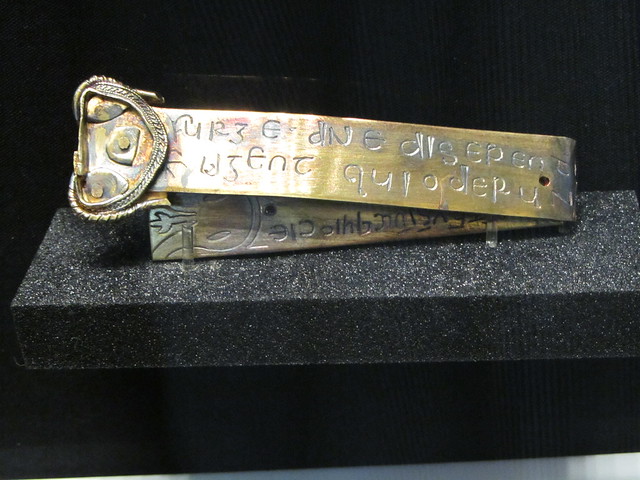There is no doubt from the style of the pieces that they are from the Anglo Saxon period, but an exact date has yet to be agreed for them. Archaeologists are trying to determine what is known as a 'terminus post quem' (limit after which). The argument goes that the stash must have been buried at some point after the date of the newest item.
 |
| Pic from: staffordshirehoard.org.uk |
A great deal of the specimens are items connected with warfare and fighting. For example there are pieces of armour, including a high status helmet. Other examples include a hilt plate from a single-edged knife (called a seax). And there are more than 70 sword pommels (the bit at the end of the grip) including one whose design is unique to this collection.
 |
| Pic from: staffordshirehoard.org.uk |
The top photo shows a replica of an inscribed strip. It is believed that it was part of a cross that might have been mounted on the cover of a prayer book or gospel. The inscription is from the Bible and is in Vulgate Latin. "Rise up, O Lord, and may thy enemies be dispersed and those who hate thee be driven from thy face." Other items in the collection show clear evidence of pagan symbolism. A few show both pagan and christian symbols together.Clearly it was a time of change.
And why is the photo of a replica? Because it appears at any time that originals are on display you are discouraged from photographing them. (This is why the remaining photos are from the hoard's official website.) Part of the stash is on display at the Potteries Museum and Art Gallery in Stoke on Trent, part in Birmingham Museum and Art Gallery, some pieces at Tamworth Castle, and there is even a selection in a touring exhibition that is currently in Burton on Trent.
The inscription photo was taken at the exhibition in Lichfield Cathedral some time ago. I'm not sure what difference it makes that only replicas were on show (of anything significant anyway) but Cathedral bosses allowed cameras into the display. Thank you, Lichfield Cathedral.

